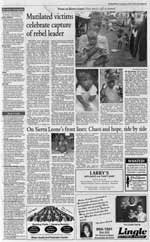Winter 2002
New Views on Old Wire Stories
By Cheryl Gibbs
Assistant Journalism Professor
Earlham College, Richmond, IN
After U.S. bombs started dropping in Afghanistan, Texas newspapers helped readers get a picture of the country’s size by reporting that it is slightly smaller than their home state.
In Seattle, newspapers used the same comparison – probably because it’s in the CIA World Factbook, which wire services use heavily. Similarly, newspapers reported that the population of Afghanistan was 25.8 milllion.
But wouldn’t it have been more meaningful to tell Washington state citizens that Afghanistan is about as big as Washington, Oregon and Idaho put together but that its population is 2 1/2 times greater than the three states?
These ideas were explored last year in a study of how to make national and international wire stories more meaningful to readers.
In the aftermath of the Sept. 11 attacks, there has been renewed interest in the study, which I coordinated with five journalism students and a group of journalists from the Dayton (OH) Daily News and the (Richmond, IN) Palladium-Item.

We created more explanatory packages of stories about national and international news – using mostly wire stories – supplemented with available information, that ran in the Palladium-Item. We then asked readers to react.
In all, we drew on input from 114 citizens in Richmond and Dayton.
The citizens told us that, generally, their interest in other countries came from a sense of personal connection through friends or family members or personal travel to that place.
Although we couldn’t create such intimate connections, we could translate demographic information into local, more personal terms. The people responded quite favorably. They also helped us see that, in our haste to give readers data about unfamiliar places, we let unexplained numbers get by that would never make it past the city desk in a local story.
For example, if we tell people the birth rate in Afghanistan is 41.4 per 1,000 as compared to 14.2 in the U.S., what does that mean exactly? We can explain those numbers the same way we explain local tax rates and environmental test results.
Our study, funded by the Pew Center and Earlham College, identified several strategies news organizations could use to make faraway stories more engaging:
- Stockpile and package more effectively wire stories, photos and graphics.
- Tell readers how they can personally help or communicate their views to decision makers.
- Localize statistics and translate them into familiar terms.
- Suggest reading lists that include literary and cultural content as well as political and historical information.
After Sept. 11, many news organizations made excellent use of the first two strategies. Regular and extra editions brimmed with dramatic photographs and graphics. And many news Web sites offered cleanly packaged background information about the terrorist attacks, the Muslim faith and Afghanistan (or links to such information online).
Moreover, nearly all news organizations told people how to donate blood or money to help the victims of the attacks and their families. But few made use of less traditional strategies that our study participants found meaningful, such as translating demographic information into more familiar terms.
Our participants told us that international news stories contribute to the public’s perception of the media as “negative.” Disasters and wars usually put countries on journalists’ radar screens. The stories tend to focus on scarcity in underdeveloped countries – poverty, inadequate health care, food shortages – without making any effort to convey the countries’ assets, they said.
For instance, most background stories and “suggested reading” lists about Afghanistan focus on the country’s relatively recent violent history, oppressive politics and harsh living conditions – especially for women. Few indicated anything pleasant about life there.
It became clear in the study that journalists tend to turn to official sources for background information. But the students suggested we look for information they might have gotten in their humanities classes.
Travel guides turned out to be a handy source. Take, for example, this excerpt from the “Lonely Planet’s Guide to Afghanistan:”
Afghanistan’s Islamic heritage is also the basis of its famous hospitality: If you – male or female, Muslim or not – are invited into a home, expect to be treated with a respect not often understood in the West.
Similarly, “Lonely Planet” tells us that the name of the country’s Hindu Kush mountain range means “killer of Hindus.” Its recommended reading list includes one of the modern classics of travel writing, “A Short Walk in the Hindu Kush,” by Eric Newby.
Our focus groups responded extremely favorably when we included this kind of material along with historical and political information.
Our recommendations were well received, but they did not seem very feasible a year ago, even at the two partner newspapers. The AP and other wire editors simply didn’t have the time or resources to do the supplementary reporting.
Perhaps now, some of these ideas will have renewed value.
